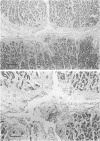Abstract
Transmyocardial laser revascularization, a new surgical technique, is being tested in patients with chronic obstructive coronary artery disease that is refractory to conventional revascularization techniques and to maximal medical therapy. During the operation, which is performed on the beating heart through a left thoracotomy, a high-energy CO2 laser is used to bore transmural channels (1 mm in diameter) into the left ventricle. Each high-energy laser pulse is delivered during end diastole and transects the heart within 10 to 60 msec. The operation is based on the theory that blood will flow directly from the left ventricle into the channels and then into the myocardial vascular plexus. Restoring perfusion should alleviate ischemia in potentially viable myocardium and improve ventricular function. Recently, one of our patients died 3 months after transmyocardial laser revascularization of causes unrelated to the operation. Histologic analysis enabled us to obtain, for the 1st time, anatomic evidence of patent laser channels. Routine staining of cardiac tissue with hematoxylin and eosin revealed multiple patent channels, running perpendicular to and interconnecting with the native vasculature. Although reactive fibrous scar tissue had caused narrowing of the original laser tract, the channels had endothelialized and they contained red blood cells. These findings suggest that the laser channels were functional. We report this interesting case and briefly discuss the anatomic and physiologic phenomena involved in establishing camerosinusoidal blood flow by use of transmyocardial laser revascularization.
Full text
PDF




Images in this article
Selected References
These references are in PubMed. This may not be the complete list of references from this article.
- Baird R. J., Manktelow R. T., Shah P. A., Ameli F. M. Intramyocardial pressure. A study of its regional variations and its relationship to intraventricular pressure. J Thorac Cardiovasc Surg. 1970 Jun;59(6):810–823. [PubMed] [Google Scholar]
- Beck C. S. THE DEVELOPMENT OF A NEW BLOOD SUPPLY TO THE HEART BY OPERATION. Ann Surg. 1935 Nov;102(5):801–813. doi: 10.1097/00000658-193511000-00001. [DOI] [PMC free article] [PubMed] [Google Scholar]
- Cigarroa C. G., deFilippi C. R., Brickner M. E., Alvarez L. G., Wait M. A., Grayburn P. A. Dobutamine stress echocardiography identifies hibernating myocardium and predicts recovery of left ventricular function after coronary revascularization. Circulation. 1993 Aug;88(2):430–436. doi: 10.1161/01.cir.88.2.430. [DOI] [PubMed] [Google Scholar]
- DiSciascio G., Angelini P., Vandormael M. G., Brinker J. A., Cowley M. J., Dean L. S., Douglas J. S., Jr Reduction of ischemia with a new flow-adjustable hemoperfusion pump during coronary angioplasty. The Coronary Hemoperfusion Ischemia Prevention Study (CHIPS) Investigators. J Am Coll Cardiol. 1992 Mar 1;19(3):657–662. doi: 10.1016/s0735-1097(10)80288-8. [DOI] [PubMed] [Google Scholar]
- Fujita M., Ohno A., Wada O., Miwa K., Nozawa T., Yamanishi K., Sasayama S. Collateral circulation as a marker of the presence of viable myocardium in patients with recent myocardial infarction. Am Heart J. 1991 Aug;122(2):409–414. doi: 10.1016/0002-8703(91)90993-r. [DOI] [PubMed] [Google Scholar]
- Hardy R. I., Bove K. E., James F. W., Kaplan S., Goldman L. A histologic study of laser-induced transmyocardial channels. Lasers Surg Med. 1987;6(6):563–573. doi: 10.1002/lsm.1900060617. [DOI] [PubMed] [Google Scholar]
- MASSIMO C., BOFFI L. Myocardial revascularization by a new method of carrying blood directly from the left ventricular cavity into the coronary circulation. J Thorac Surg. 1957 Aug;34(2):257–264. [PubMed] [Google Scholar]
- Mirhoseini M., Cayton M. M., Shelgikar S., Fisher J. C. Laser myocardial revascularization. Lasers Surg Med. 1986;6(5):459–461. doi: 10.1002/lsm.1900060507. [DOI] [PubMed] [Google Scholar]
- Mirhoseini M., Muckerheide M., Cayton M. M. Transventricular revascularization by laser. Lasers Surg Med. 1982;2(2):187–198. doi: 10.1002/lsm.1900020209. [DOI] [PubMed] [Google Scholar]
- Pifarré R. Intramyocardial pressure during systole and diastole. Ann Surg. 1968 Nov;168(5):871–875. doi: 10.1097/00000658-196811000-00013. [DOI] [PMC free article] [PubMed] [Google Scholar]
- Pifarré R., Jasuja M. L., Lynch R. D., Neville W. E. Myocardial revascularization by transmyocardial acupuncture. A physiologic impossibility. J Thorac Cardiovasc Surg. 1969 Sep;58(3):424–431. [PubMed] [Google Scholar]
- SEN P. K., UDWADIA T. E., KINARE S. G., PARULKAR G. B. TRANSMYOCARDIAL ACUPUNCTURE: A NEW APPROACH TO MYOCARDIAL REVASCULARIZATION. J Thorac Cardiovasc Surg. 1965 Aug;50:181–189. [PubMed] [Google Scholar]
- Sabbah H. N., Stein P. D. Relation of intramyocardial and intracavitary pressure to regional myocardial asynergy in the canine left ventricle. Am Heart J. 1983 Mar;105(3):380–386. doi: 10.1016/0002-8703(83)90353-8. [DOI] [PubMed] [Google Scholar]
- Sen P. K., Daulatram J., Kinare S. G., Udwadia T. E., Parulkar G. B. Further studies in multiple transmyocardial acupuncture as a method of myocardial revascularization. Surgery. 1968 Nov;64(5):861–870. [PubMed] [Google Scholar]
- Vineberg A. M. RESTORATION OF CORONARY CIRCULATION BY ANASTOMOSIS. Can Med Assoc J. 1946 Aug;55(2):117–119. [PMC free article] [PubMed] [Google Scholar]
- Wakabayashi A., Little S. T., Jr, Connolly J. E. Myocardial boring for the ischemic heart. Arch Surg. 1967 Nov;95(5):743–752. doi: 10.1001/archsurg.1967.01330170051007. [DOI] [PubMed] [Google Scholar]
- Whittaker P., Kloner R. A., Przyklenk K. Laser-mediated transmural myocardial channels do not salvage acutely ischemic myocardium. J Am Coll Cardiol. 1993 Jul;22(1):302–309. doi: 10.1016/0735-1097(93)90848-u. [DOI] [PubMed] [Google Scholar]




